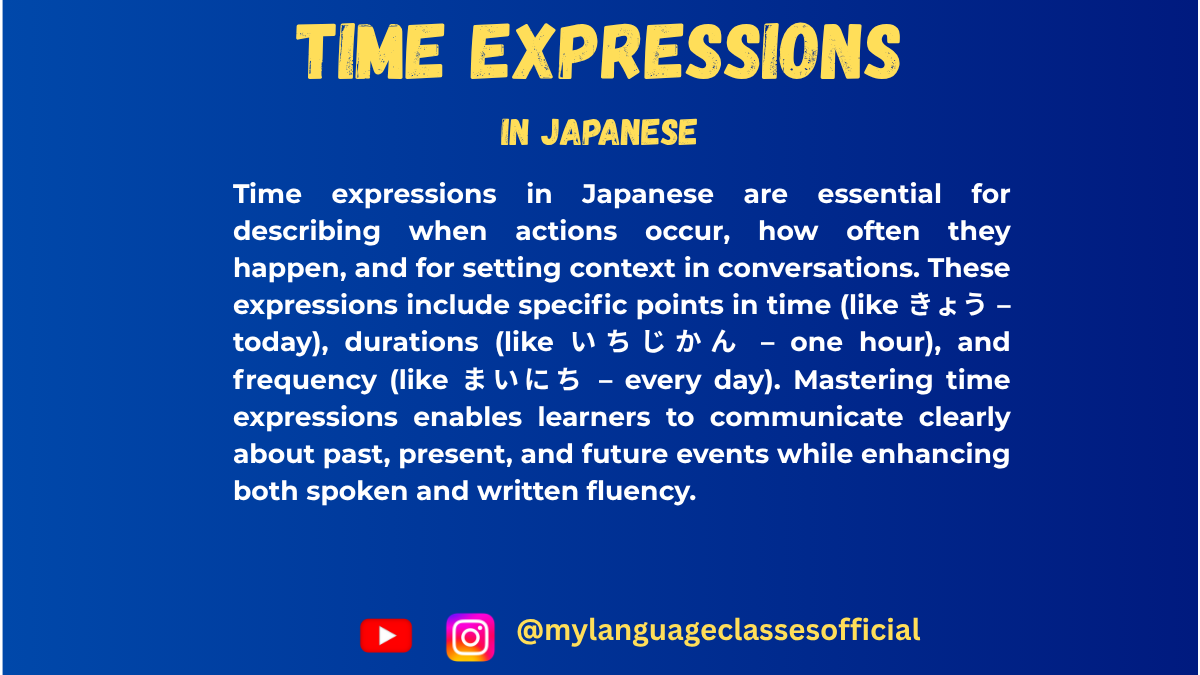Your cart is currently empty!
Tag: Japanese basics
-
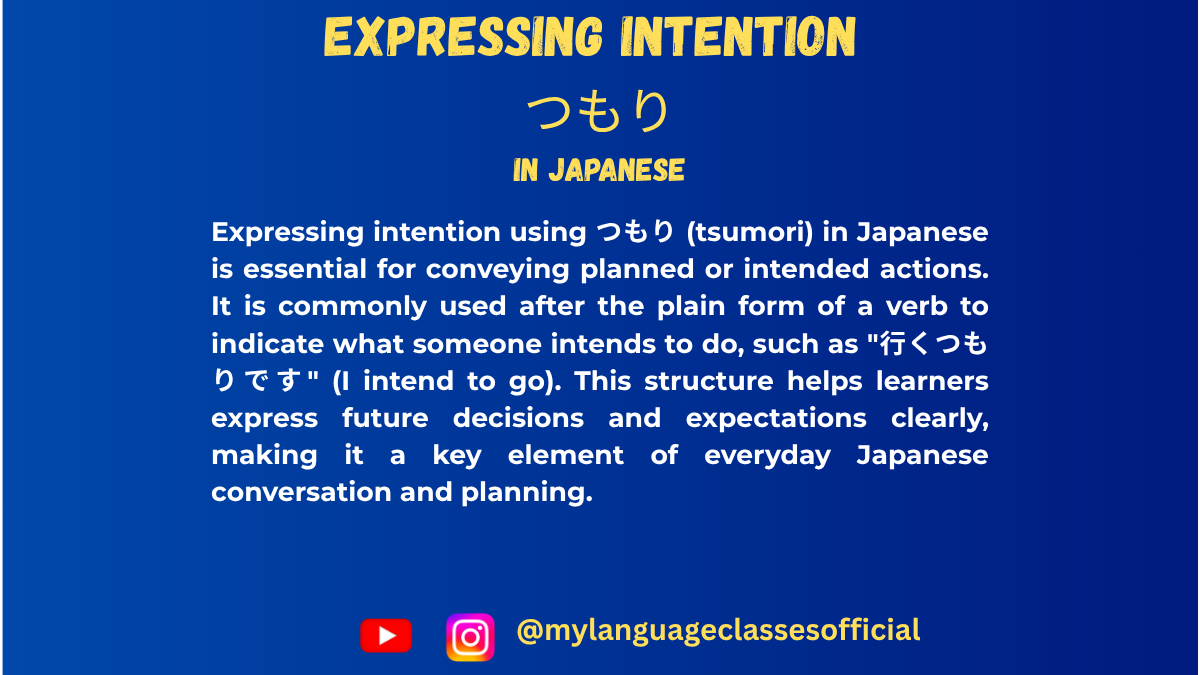
Expressing Intention in Japanese:つもり| My Language Classes
How to Show Intention in Japanese
When learning Japanese, understanding how to articulate intentions or plans is crucial. One of the most common and versatile expressions for this purpose is 〜つもり (tsumori). This post explores the usage of 〜つもり, its nuances, and the various situations where it can be employed.
What is 〜つもり?
〜つもり is a grammatical structure used to express one’s intention, determination, or a plan to do something. It can also convey assumptions or beliefs in certain contexts. The term “tsumori” itself translates to “intention” or “plan.”
The construction is relatively simple:
[Verb in dictionary form] + つもりです – Intend to do something.
[Verb in nai-form] + つもりです – Intend not to do something.
How to Use 〜つもり?
1. Expressing Future Intentions
You can use 〜つもり to clearly state your plans for the future:
- 私は明日学校に行くつもりです。 – I intend to go to school tomorrow.
- 私は歌をうたわないつもりです。 – I intend not to sing a song.
2. Talking About Assumptions
〜つもり can also indicate a belief or assumption about a situation, often with an implied contrast to reality:
- 私は深く理解しているつもりでした。しかし…。 – I thought I understood it deeply, but…
This usage typically involves a past-tense verb and often reflects a misunderstanding.
3. Expressing Unintentional Actions
Although rare, 〜つもり is used to deny responsibility when you didn’t intentionally perform an action:
- それを言うつもりはなかった。 – I didn’t mean to say that.
Politeness Levels
〜つもりです is a polite expression suitable for formal and semi-formal settings. In casual conversations, you can drop です:
- 明日行くつもり。 – I plan to go tomorrow.
Adding 「つもりだよ」 or 「つもりだけど」 softens the tone even further.
Key Situations for Using 〜つもり
Here’s a comprehensive list of contexts where 〜つもり is commonly used:
- Future Plans:
- 私は明日山に行くつもりです。 – I intend to go to the mountains tomorrow.
- Negating Intentions:
- 今年は流行の服を買わないつもりです。 – I don’t plan to buy trendy clothes this year.
- Explaining Changes in Plans:
- 行くつもりだったけど、天気が悪くなりました。 – I intended to go, but the weather turned bad.
- Making Assumptions:
- 自分は結婚しないつもりでしたが…。 – I assumed I wouldn’t get married, but…
- Unintentional Actions:
- あなたを傷つけるつもりはありません。 – I didn’t intend to hurt you.
- Future Determination:
- もっと勉強するつもりです。 – I am determined to study harder.
Common Mistakes to Avoid
- Misinterpreting 〜つもり as a Promise: While 〜つもり expresses intention, it doesn’t guarantee that the action will happen. Avoid confusing it with words like やくそく (yakusoku – promise).
- Using 〜つもり in Commands or Requests: 〜つもり cannot be used to make requests or issue commands.
- Overusing in Formal Writing: In highly formal contexts, more precise expressions like 計画しています (“I am planning”) may be more appropriate.
Practice Examples
Try constructing sentences using 〜つもり in different situations. For instance:
- 私は今年日本語を終わらせるつもりです。
- 私はその話を聞いたつもりですが…
By practicing various scenarios, you’ll gain confidence in using this versatile expression.
Understanding 〜つもり is a valuable step in mastering Japanese. It allows you to articulate intentions, beliefs, and assumptions effectively. Whether planning a trip, expressing a future goal, or clarifying misunderstandings, this structure adds depth to your language skills. Happy studying!
If you enjoyed this lesson, be sure to check out more posts like this on my blog at My Language Classes. Don’t forget to subscribe my YouTube channel and follow me on Instagram for the latest language learning tips and lessons. Leave a comment below to share your thoughts, or ask any questions you have about nouns.
Happy learning! 😊
-

How to Use かもしれない | My Language Classes
Expressing Possibility in Japanese: かもしれない
When learning Japanese, understanding how to express possibility or uncertainty is essential for nuanced communication. The phrase かもしれない (かも) is a versatile and frequently used expression in Japanese to indicate that something “might” happen or “could” be the case. In this blog post, we will delve deeply into the usage of かもしれない, including its grammatical structure, variations, and common situations where it is used.
What Does かもしれない Mean?
かもしれない literally translates to “might” or “could,” expressing a sense of possibility or uncertainty about a situation. It is often used when the speaker is unsure about the likelihood of an event or fact but wants to acknowledge its potentiality.
Variations in Formality:
- Casual: かもしれない
- Polite: かもしれません
- Abbreviated (Casual Speech): かも
- Example: これは大変かも。 (This could be serious.)
Grammatical Structure
かもしれない follows directly after a predicate and can attach to various parts of speech:
- Nouns:
- Structure: [Noun] + かもしれない
- Example: これはプレゼントかもしれない。 (This might be a present.)
- Adjectives (i-adjectives):
- Structure: [i-adjective] + かもしれない
- Example: あの店は高いかもしれない。 (That shop might be expensive.)
- Adjectives (na-adjectives):
- Structure: [na-adjective] + だ + かもしれない
- Example: この話は大事だかもしれない。 (This story might be important.)
- Verbs:
- Structure: [Verb (plain form)] + かもしれない
- Example: かれは来るかもしれない。 (He might come.)
Key Points to Remember
- Degree of Possibility: かもしれない implies a low to moderate degree of certainty. It’s not used for highly probable events.
- Uncertainty Tone: This expression adds a soft, non-committal tone to statements, making it useful in conversations where certainty is lacking.
- Position in Sentence:
- Always follows the predicate directly.
- Cannot be used at the start of a sentence.
- Politeness: Use かもしれません in formal situations or when speaking to superiors.
Common Situations to Use かもしれない
Here are some typical scenarios where かもしれない is used:
1. Guessing About Someone’s Actions:
- 他は明日会社に来ないかもしれない。
(He might not come to the office tomorrow.)
2. Weather Predictions:
- 今夜は雨が降るかもしれない。
(It might rain tonight.)
3. Speculating About the Past:
- 他はこのテストに落ちたかもしれない。
(He might have failed this test.)
4. Expressing Caution:
- その道は危ないかもしれない。
(That path might be dangerous.)
5. Making Suggestions With Hesitation:
- これを使ったら良い結果がでるかもしれない。
(Using this might give good results.)
6. Talking About Plans:
- 私は今年日本へ行くかもしれない。
(I might go to Japan this year.)
7. Health Concerns:
- あなたは病気になりかけているかもしれない。
(You might be getting sick.)
Practical Notes on Usage
- Avoid Overuse: While かもしれない is useful, overusing it can make your statements seem overly speculative.
- Alternative Phrases:
- Instead of かもしれない, consider using 可能性がある (かのうせいがある, “there is a possibility”) for more formal contexts.
- Context Matters:
- Use かもしれない sparingly in professional or serious settings where certainty is preferred.
Practice Exercise
Complete the following sentences with かもしれない:
- 今日はカラオケが出る…。
(It might snow today.) - あの人はこの仕事をキャンセルする…。
(That person might cancel this task.) - この商品は新品じゃない…。
(This product might not be new.)
Conclusion
かもしれない is a subtle yet powerful expression for conveying possibility and uncertainty in Japanese. By mastering its usage, you can add nuance to your conversations and sound more natural when speaking Japanese. Practice using it in different scenarios, and you’ll find it becoming a natural part of your language toolbox!
If you enjoyed this lesson, be sure to check out more posts like this on my blog at My Language Classes. Don’t forget to subscribe my YouTube channel and follow me on Instagram for the latest language learning tips and lessons. Leave a comment below to share your thoughts, or ask any questions you have about nouns.
Happy learning! 😊
-

Understanding 〜でしょう/だろう in Japanese | My Language Classes
Expressions used to indicate probability, conjecture, or seeking confirmation
If you’re diving into the world of Japanese grammar, the particle でしょう (deshou) is one you’ll encounter frequently. It’s a versatile expression that conveys probability, speculation, or seeks confirmation. In this blog post, we’ll explore all the nuances of でしょう, its various uses, and how it interacts with other elements of the language.
1. What is でしょう?
でしょう is the polite form of だろう, which itself is derived from the copula だ (used to state facts). Depending on the context and tone, it can mean:
- “Probably”
- “I suppose”
- “Right?” (as a tag question seeking agreement)
- “It seems that”
Forming でしょう
- Nouns/Na-adjectives:
Add でしょう after the plain form.
Example:
学生 でしょう。 (It’s probably a student.) - I-adjectives:
Attach directly to the base form.
Example:
暑い でしょう。 (It’s probably hot.) - Verbs:
Attach to the plain form.
Example:
行く でしょう。 (He/she/they will probably go.)
2. Expressing Probability
One of the most common uses of でしょう is to express probability or likelihood. It’s often used when the speaker wants to indicate that something is likely true based on their knowledge or perception.
Examples:
- 明日は雨が降る でしょう。
(It will probably rain tomorrow.) - あの映画は面白い でしょう。
(That movie is probably interesting.)
In these cases, でしょう is equivalent to saying “probably” or “I think” in English. It softens the statement, showing that the speaker is not asserting something as a definite fact.
3. Asking for Confirmation
When used with a rising intonation, でしょう turns into a tag question, seeking agreement or confirmation from the listener. It can be translated as “right?” or “isn’t it?” in English.
Examples:
- このケーキ、美味しい でしょう?
(This cake is delicious, isn’t it?) - 彼は先生 でしょう?
(He’s a teacher, right?)
The rising tone at the end signals the speaker is looking for confirmation or agreement.
4. Making Guesses or Predictions
You’ll often hear でしょう in weather forecasts, news reports, or any context where predictions are made.
Examples:
- 明日の天気は晴れ でしょう。
(Tomorrow’s weather will probably be sunny.) - この問題は簡単 でしょう。
(This problem is probably easy.)
In such cases, the speaker uses でしょう to make a statement that isn’t 100% certain but is backed by reasonable evidence or context.
5. でしょう in Casual Speech: だろう
In informal situations, だろう is often used instead of でしょう, especially by men. While だろう serves the same functions, it feels less polite and more casual.
Examples:
- あれは本物のダイヤモンド だろう。
(That’s probably a real diamond.) - 今日は忙しい だろう?
(You’re busy today, right?)
6. Negative Forms
The negative equivalent of でしょう is formed by negating the predicate or verb.
Examples:
- あのレストランは高くない でしょう。
(That restaurant is probably not expensive.) - 彼は来ない でしょう。
(He probably won’t come.)
7. Using でしょう in Hypothetical or Conditional Contexts
When paired with the conditional たら or similar structures, でしょう can express speculation about hypothetical situations.
Examples:
- あの店に行ったら、何か美味しいものがある でしょう。
(If we go to that store, there will probably be something delicious.) - もっと勉強したら、試験に合格する でしょう。
(If you study more, you will probably pass the exam.)
8. Cultural Nuances and Subtleties
In Japanese communication, でしょう plays a role in maintaining politeness and avoiding direct assertions. By using でしょう, the speaker softens their statements, allowing room for the listener’s interpretation or input. This aligns with Japanese cultural norms that emphasize indirectness and respect for others’ perspectives.
For example:
- 今日は寒いです。 (It’s cold today.)
→ Direct and factual. - 今日は寒いでしょう。 (It’s probably cold today.)
→ Politer, leaving room for the listener’s agreement or alternative opinion.
9. Common Pitfalls and Misunderstandings
- でしょう vs かもしれない:
Both express uncertainty, but かもしれない conveys a lower degree of certainty compared to でしょう.
Example:
彼は来る でしょう。 (He will probably come.)
彼は来る かもしれない。 (He might come.) - Overuse in Confirmation Questions:
While でしょう is great for seeking agreement, overusing it can make your speech sound repetitive. Balance it with other expressions like よね or ね for variety.
10. Final Notes
Mastering でしょう allows you to add nuance to your Japanese and navigate conversations more smoothly. It’s a fantastic tool for expressing uncertainty politely, making predictions, or asking for confirmation. Remember:
- Use でしょう for polite speech and だろう for casual contexts.
- Pay attention to intonation when seeking confirmation.
- Practice with real-life scenarios to internalize its subtleties.
Do you have any questions about でしょう or other Japanese grammar points? Share them in the comments below, and let’s learn together! 😊
If you enjoyed this lesson, be sure to check out more posts like this on my blog at My Language Classes. Don’t forget to subscribe my YouTube channel and follow me on Instagram for the latest language learning tips and lessons. Leave a comment below to share your thoughts, or ask any questions you have about nouns.
Happy learning! 😊
-
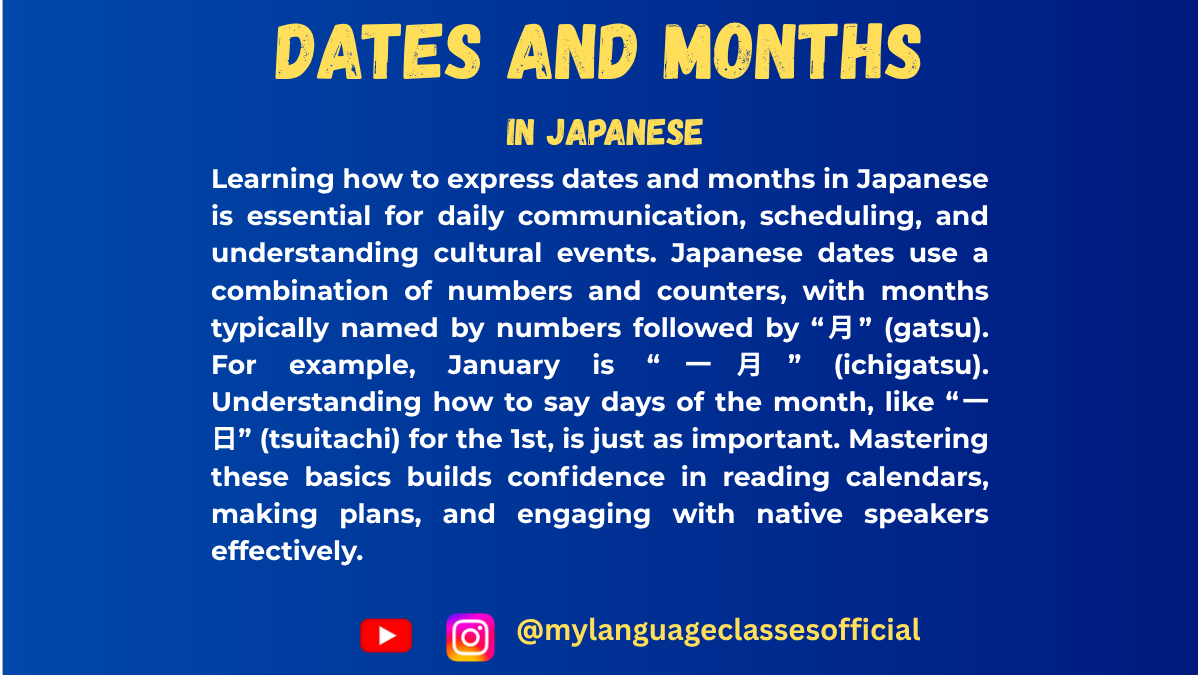
Mastering Dates and Months in Japanese | My Language Classes
Dates and Months in Japanese
こんにちは (Konnichiwa)!
If you’re learning Japanese, one of the essential skills is telling the date. Japanese has unique ways to express dates that differ from English or many other languages. In this post, we’ll cover everything you need to know about telling dates in Japanese, including a handy list of how to say specific dates and some cultural and linguistic nuances to keep in mind. Let’s dive in!
Understanding Japanese Dates: Basic Structure
In Japanese, the date format is typically written as Year-Month-Day (e.g., 2024年12月25日, 2024-12-25). The characters used are:
- 年 (nen) for “year”
- 月 (gatsu) for “month”
- 日 (nichi) for “day”
For example:
- 2024年12月25日 = “2024 December 25”
- Read as: にせんにじゅうよねん じゅうにがつ にじゅうごにち (Nisen-nijūyo-nen, jūni-gatsu, nijūgo-nichi)
Days of the Month in Japanese
Japanese has specific terms for the first 10 days and certain other days of the month. Here’s a list of the most common:
1st to 10th and 20th (Special Readings):
- 1日 (ついたち) – Tsuitachi
- 2日 (ふつか) – Futsuka
- 3日 (みっか) – Mikka
- 4日 (よっか) – Yokka
- 5日 (いつか) – Itsuka
- 6日 (むいか) – Muika
- 7日 (なのか) – Nanoka
- 8日 (ようか) – Yōka
- 9日 (ここのか) – Kokonoka
- 10日 (とおか) – Tōka
- 20日 (はつか) – Hatsuka
Days After the 10th:
For days after the 10th (except 20th), simply use the number + 日 (にち, nichi). For example:
- 11th = 11日 (じゅういちにち) – Jūichi-nichi
- 12th = 12日 (じゅうににち) – Jūni-nichi
- 13th = 13日 (じゅうさんにち) – Jūsan-nichi
Continue this pattern up to the 31st:
- 21st = 21日 (にじゅういちにち) – Nijūichi-nichi
- 30th = 30日 (さんじゅうにち) – Sanjū-nichi
- 31st = 31日 (さんじゅういちにち) – Sanjūichi-nichi
Months in Japanese
Months in Japanese are much simpler. They are numbered from 1 to 12 followed by 月 (gatsu). For example:
- January = 1月 (いちがつ) – Ichigatsu
- February = 2月 (にがつ) – Nigatsu
- March = 3月 (さんがつ) – Sangatsu …and so on.
Key Grammar and Usage Notes
1. No Articles:
Unlike English, Japanese does not use articles like “the” or “a.” So, you simply state the date without worrying about additional words.
2. No Plural Forms:
Japanese nouns do not have plural forms. For example, the word 日 (nichi) stays the same whether you’re talking about one day or many days.
3. Gender-neutral Language:
Japanese does not have gender-specific nouns or articles. The way you say dates remains the same regardless of who is speaking or listening.
4. Pronunciation Challenges:
- Pay special attention to the unique readings for the 1st to 10th and the 20th.
- Be careful with long vowels, such as in ようか (8th), where the “ou” sound must be elongated.
5. Cultural Context:
When writing or saying the date in Japanese, it’s common to follow the year-month-day structure. If you’re addressing someone formally, especially in written communication, add です (desu) or でございます (de gozaimasu) for politeness.
Practice Makes Perfect!
Here’s an example of a complete date in Japanese:
- Today is December 25, 2024
→ 2024年12月25日です
→ にせんにじゅうよねん じゅうにがつ にじゅうごにち です
Pro Tips for Fluency
- Memorize the unique readings for the 1st to 10th and 20th – These are the most irregular and require rote learning.
- Practice with real dates – Try saying your birthday, important holidays, or even today’s date.
- Listen to native speakers – Watch Japanese TV shows, listen to podcasts, or use language apps to hear how dates are pronounced naturally.
Now that you’ve mastered dates in Japanese, try using them in conversation! Whether you’re booking an appointment or celebrating a special occasion, understanding how to express dates will bring you one step closer to fluency.
If you enjoyed this lesson, be sure to check out more posts like this on my blog at My Language Classes. Don’t forget to subscribe my YouTube channel and follow me on Instagram for the latest language learning tips and lessons. Leave a comment below to share your thoughts, or ask any questions you have about nouns.
Happy learning! 😊
-
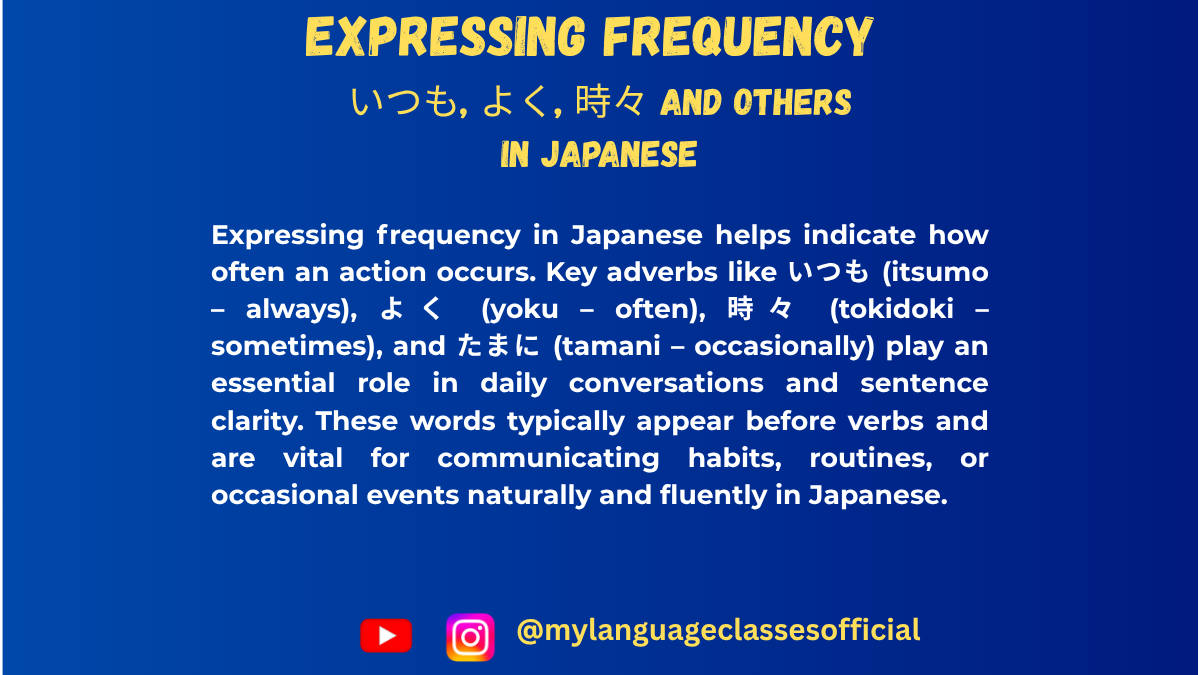
Expressing Frequency in Japanese | My Language Classes
How to Talk About Frequency in Japanese
Learning how to express frequency is an essential part of mastering any language. In Japanese, there are various ways to indicate how often something happens, ranging from daily habits to rare occurrences. This guide will provide all the patterns and tips you need to express frequency like a native speaker.
Basic Frequency Vocabulary
Here are some common adverbs used to express frequency in Japanese:
Japanese Romaji English Translation Example Sentence いつも itsumo always 私はいつも朝ごはんを食べます。
(Watashi wa itsumo asagohan o tabemasu.)
I always eat breakfast.よく yoku often 彼はよく映画を見ます。
(Kare wa yoku eiga o mimasu.)
He often watches movies.時々 tokidoki sometimes 私は時々本を読みます。
(Watashi wa tokidoki hon o yomimasu.)
I sometimes read books.たまに tamani occasionally たまに外食します。
(Tamani gaishoku shimasu.)
I occasionally eat out.あまり amari not often (with negation) 私はあまりテレビを見ません。
(Watashi wa amari terebi o mimasen.)
I don’t watch TV often.全然 zenzen never (with negation) 彼女は全然運動しません。
(Kanojo wa zenzen undou shimasen.)
She never exercises.
Patterns for Expressing Frequency
- Using Adverbs
Frequency adverbs are usually placed before the verb they modify.- Example: 私はよくカフェに行きます。
(Watashi wa yoku kafe ni ikimasu.)
I often go to cafes.
- Example: 私はよくカフェに行きます。
- Time Expressions with Frequency Indicators
To specify how often something happens, combine time expressions with frequency words like 回 (kai, “times”) or 度 (do, “times”).- Pattern:
- Time + に (ni) + Number + 回 (kai)
- Example: 一週間に三回ジムに行きます。
(Isshuukan ni sankai jimu ni ikimasu.)
I go to the gym three times a week.
- Pattern:
- Using 毎 (mai) for Recurring Activities
The prefix 毎 (mai) means “every” and is used to indicate regularity.- Examples:
- 毎日 (mainichi) – every day
- 毎週 (maishuu) – every week
- 毎月 (maigetsu/maitsuki) – every month
- 毎年 (mainen/maitoshi) – every year
- Example Sentence: 私は毎朝ジョギングをします。
(Watashi wa maiasa jogingu o shimasu.)
I jog every morning.
- Examples:
- Using ~ごとに (~goto ni)
This suffix indicates regular intervals.- Example: 二日ごとに掃除します。
(Futsuka goto ni souji shimasu.)
I clean every two days.
- Example: 二日ごとに掃除します。
- Expressing Negative Frequency
When using words like あまり (amari) or 全然 (zenzen), they must be paired with a verb in the negative form.- Examples:
- 彼はあまり勉強しません。
(Kare wa amari benkyou shimasen.)
He doesn’t study much. - 私は全然泳ぎません。
(Watashi wa zenzen oyogimasen.)
I never swim.
- 彼はあまり勉強しません。
- Examples:
Things to Keep in Mind
- Context Matters
- The frequency you use depends on the situation. For instance, using “always” (いつも) too often might make you sound exaggerated or unnatural in casual speech.
- Cultural Nuances
- Japanese people often use frequency expressions to politely imply how often they perform an action, even if it’s not true all the time. For instance, saying “よくやります” (I often do it) can sometimes serve as a polite expression rather than an exact frequency.
- Differentiating 回 (kai) and 度 (do)
- 回 (kai) is more common in casual speech, while 度 (do) can feel more formal or traditional.
- Practice Pronunciation
- Properly enunciate frequency adverbs for clarity. For instance, たまに (tamani) and 時々 (tokidoki) should not be rushed when speaking.
Practical Exercises
- Fill in the blanks with the correct frequency adverb:
- 私は(____)カラオケに行きます。
- Hint: If you go “sometimes,” use 時々.
- Translate the sentences into Japanese:
- I clean my room every week.
- He rarely eats sushi.
- Create Your Own Sentences:
- Write three sentences using different frequency adverbs. Share them with a friend or teacher for feedback!
By mastering these expressions and patterns, you’ll be well on your way to sounding natural and fluent in Japanese. Remember, practice makes perfect—so use these structures in your daily conversations and writing!
Have questions or need more practice examples? Let me know in the comments below!
If you enjoyed this lesson, be sure to check out more posts like this on my blog at My Language Classes. Don’t forget to subscribe my YouTube channel and follow me on Instagram for the latest language learning tips and lessons. Leave a comment below to share your thoughts, or ask any questions you have about nouns.
Happy learning! 😊
- Using Adverbs
-
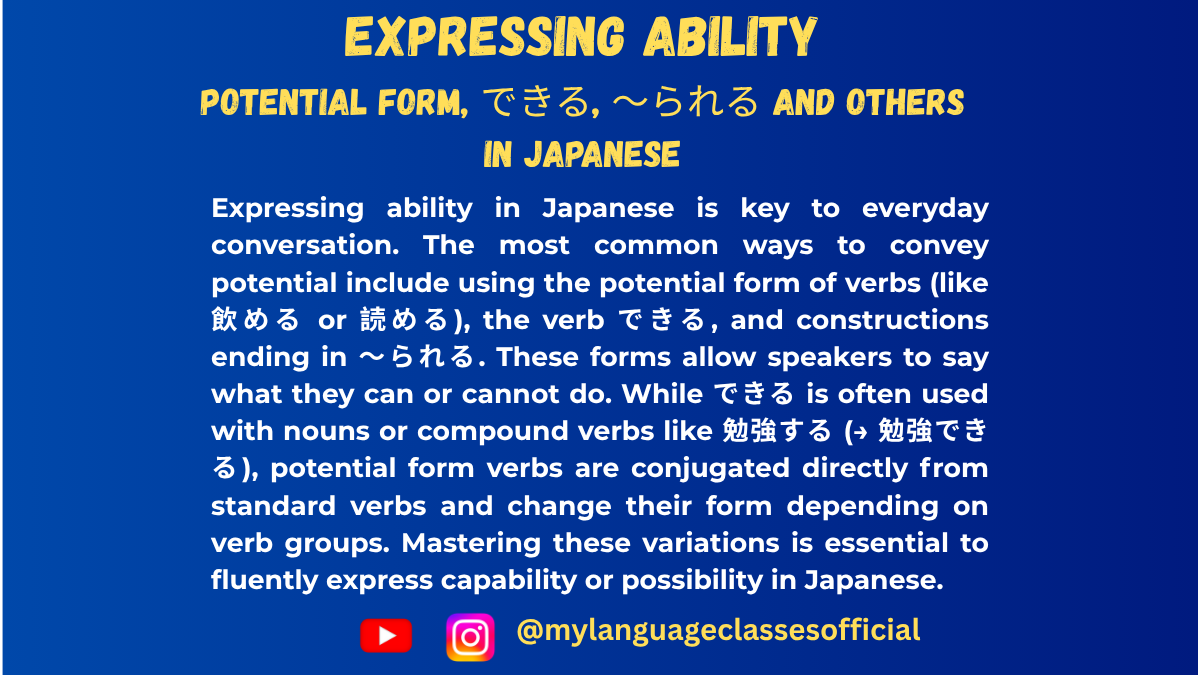
Expressing Ability in Japanese | My Language Classes
How to Express Ability in Japanese
When learning Japanese, expressing ability is an essential skill. Japanese uses specific grammatical structures to indicate whether you can do something. These expressions differ depending on the type of verb, politeness level, and context. This blog post will cover all the patterns and nuances you need to know.
1. Using Potential Form (可能形, Kanoukei)
The potential form of verbs is the most common way to express ability in Japanese. This form modifies the verb to mean “can” or “be able to.”
Formation Rules:
- Group 1 Verbs (五段動詞): Change the last “u” sound to its corresponding “e” sound and add -る.
- 書く (kaku, to write) → 書ける (kakeru, can write)
- 飲む (nomu, to drink) → 飲める (nomeru, can drink)
- Group 2 Verbs (一段動詞): Simply replace -る with -られる.
- 食べる (taberu, to eat) → 食べられる (taberareru, can eat)
- Irregular Verbs:
- する (suru, to do) → できる (dekiru, can do)
- 来る (kuru, to come) → 来られる (korareru, can come)
Usage in Sentences:
- ピアノを弾けますか? (Piano o hikemasu ka?)
Can you play the piano? - 日本語が話せます。 (Nihongo ga hanasemasu.)
I can speak Japanese.
Note: For Group 2 verbs, the shortened form 食べれる is often used in casual speech, but it may be considered grammatically incorrect in formal contexts.
2. Using the Verb できる (Dekiru)
できる is a versatile verb that expresses general ability or possibility. It is often used with nouns or “nominalized verbs” (verbs turned into nouns).
Formation Rules:
- [Noun] + ができる
- スキーができる (Sukī ga dekiru) → I can ski.
- [Verb in dictionary form] + ことができる
- 本を読むことができる (Hon o yomu koto ga dekiru) → I can read books.
Usage in Sentences:
- 私は泳ぐことができません。 (Watashi wa oyogu koto ga dekimasen.)
I cannot swim. - 新しいゲームができる。 (Atarashii geemu ga dekiru.)
I can play a new game.
Tip: Use できる for broader abilities or formal contexts, while the potential form of verbs is more direct.
3. Expressing Inability with できない and Potential Form
The negative forms of できる and potential verbs are used to express inability.
- 書けない (kakenai, cannot write)
- 飲めない (nomenai, cannot drink)
- できない (dekinai, cannot do)
Examples:
- 車を運転できません。 (Kuruma o unten dekimasen.)
I cannot drive a car. - 漢字が読めない。 (Kanji ga yomenai.)
I cannot read kanji.
4. Using Expressions with 〜られる in Daily Conversation
In casual conversation, 〜られる forms often sound softer and less assertive. You can use them to express possibilities or abilities politely.
Examples:
- この本、読めますか? (Kono hon, yomemasu ka?)
Can you read this book? - 外国語は難しいけど、頑張れば話せるよ! (Gaikokugo wa muzukashii kedo, ganbareba hanaseru yo!)
Foreign languages are hard, but you can speak them if you try!
5. Using ~ことがある to Talk About Situational Ability
You can also use ~ことがある to describe situations where something is possible or permissible.
Examples:
- 会議室を使うことができますか? (Kaigishitsu o tsukau koto ga dekimasu ka?)
Is it possible to use the meeting room? - この公園で遊ぶことができます。 (Kono kōen de asobu koto ga dekimasu.)
You can play in this park.
6. Things to Keep in Mind
- Politeness Levels:
Adjust the verb endings according to the situation. For example:- Polite: 話せます (hanasemasu)
- Casual: 話せる (hanaseru)
- Using が vs. を:
When expressing ability, the object marker changes from を to が:- ピアノを弾く → ピアノが弾ける
- Cultural Sensitivity:
Japanese speakers often avoid being overly assertive about their abilities. Phrases like ちょっと難しいです (chotto muzukashii desu, “It’s a bit difficult”) can soften the tone.
7. Practice Sentences for Learners
- 明日、山に登れますか? (Ashita, yama ni noboremasu ka?)
Can you climb the mountain tomorrow? - 子どもの時、泳ぐことができました。 (Kodomo no toki, oyogu koto ga dekimashita.)
When I was a child, I could swim. - 日本語でメールを書けますか? (Nihongo de mēru o kakemasu ka?)
Can you write an email in Japanese?
Expressing ability in Japanese can feel tricky at first, but with practice, it becomes natural. Master these forms, and you’ll be able to communicate your skills and understand others effortlessly!
Have questions or want more examples? Share them in the comments below! 🌸
If you enjoyed this lesson, be sure to check out more posts like this on my blog at My Language Classes. Don’t forget to subscribe my YouTube channel and follow me on Instagram for the latest language learning tips and lessons. Leave a comment below to share your thoughts, or ask any questions you have about nouns.
Happy learning! 😊
- Group 1 Verbs (五段動詞): Change the last “u” sound to its corresponding “e” sound and add -る.
-

Mastering Degree Words in Japanese | My Language Classes
Mastering Degree Expressions in Japanese
Degree expressions in Japanese are essential tools for describing intensity, extent, or degree of an action or quality. They are commonly used in daily conversation and writing, adding nuance and specificity to your expressions. This blog post explores patterns like とても (“very”) and あまり (“not very”) along with other degree expressions, providing details on their usage, nuances, and examples.
1. Basic Degree Expressions
とても (Totemo) – “Very”
- Usage: Used to emphasize a high degree of something.
- Structure:
とても + adjective/adverb
Example:- このケーキはとてもおいしいです。
(Kono kēki wa totemo oishii desu.)
→ This cake is very delicious. - 彼はとても速く走ります。
(Kare wa totemo hayaku hashirimasu.)
→ He runs very fast.
- このケーキはとてもおいしいです。
あまり (Amari) – “Not very” (with negative forms)
- Usage: Indicates a low degree of something and is used with negative forms of verbs or adjectives.
- Structure:
あまり + negative form of adjective/verb
Example:- あの映画はあまりおもしろくなかったです。
(Ano eiga wa amari omoshiroku nakatta desu.)
→ That movie wasn’t very interesting. - 天気はあまり良くありませんでした。
(Tenki wa amari yoku arimasen deshita.)
→ The weather wasn’t very good.
- あの映画はあまりおもしろくなかったです。
2. Other Common Degree Expressions
少し / ちょっと (Sukoshi / Chotto) – “A little”
- Usage: Indicates a small degree or extent. ちょっと is more casual than 少し.
- Structure:
少し/ちょっと + adjective/verb
Example:- 部屋は少し寒いです。
(Heya wa sukoshi samui desu.)
→ The room is a little cold. - ちょっと待ってください。
(Chotto matte kudasai.)
→ Please wait a moment.
- 部屋は少し寒いです。
かなり / 相当 (Kanari / Sōtō) – “Quite/Considerably”
- Usage: Indicates a significant degree, but less than とても.
- Structure:
かなり/相当 + adjective/adverb
Example:- この問題はかなり難しいです。
(Kono mondai wa kanari muzukashii desu.)
→ This problem is quite difficult. - 彼は相当疲れているようです。
(Kare wa sōtō tsukarete iru yō desu.)
→ He seems considerably tired.
- この問題はかなり難しいです。
非常に (Hijō ni) – “Extremely”
- Usage: Formal and strong degree expression, often used in written or formal contexts.
- Structure:
非常に + adjective/adverb
Example:- このテクノロジーは非常に有用です。
(Kono tekunorojī wa hijō ni yūyō desu.)
→ This technology is extremely useful.
- このテクノロジーは非常に有用です。
3. Nuanced Degree Expressions
そんなに (Sonna ni) – “So much” (with negative)
- Usage: Typically used in negative contexts to downplay something.
- Structure:
そんなに + negative form
Example:- この宿題はそんなに難しくありません。
(Kono shukudai wa sonna ni muzukashiku arimasen.)
→ This homework isn’t so difficult.
- この宿題はそんなに難しくありません。
めっちゃ / 超 (Meccha / Chō) – “Super” (Informal)
- Usage: Extremely casual and common in spoken Japanese, especially among younger people.
- Structure:
めっちゃ/超 + adjective
Example:- この店のラーメン、超うまい!
(Kono mise no rāmen, chō umai!)
→ The ramen at this place is super delicious! - 昨日はめっちゃ楽しかった。
(Kinō wa meccha tanoshikatta.)
→ Yesterday was super fun.
- この店のラーメン、超うまい!
4. Expressing Extremes
一番 (Ichiban) – “The most”
- Usage: Indicates the highest degree or rank.
- Structure:
一番 + adjective/adverb
Example:- 富士山は日本で一番高い山です。
(Fujisan wa Nihon de ichiban takai yama desu.)
→ Mount Fuji is the tallest mountain in Japan.
- 富士山は日本で一番高い山です。
最高に (Saikō ni) – “The best/most”
- Usage: Used to express the peak level of a positive quality.
- Structure:
最高に + adjective
Example:- 今日は最高に幸せです。
(Kyō wa saikō ni shiawase desu.)
→ I’m the happiest today.
- 今日は最高に幸せです。
5. Things to Keep in Mind
- Context Matters:
- Use formal expressions like 非常に in professional or academic settings.
- Opt for casual expressions like めっちゃ in informal conversations.
- Politeness Levels:
Adjust your degree expressions depending on who you are speaking to. For instance, avoid めっちゃ with your boss, and use とても or かなり instead. - Avoid Overusing:
Overloading sentences with degree expressions can make your speech sound unnatural. Be selective and intentional. - Negative Nuances:
Expressions like あまり and そんなに are inherently tied to negativity. Ensure you pair them with negative predicates.
6. Practice Makes Perfect
The best way to master degree expressions is through regular practice. Try using these patterns in daily conversation or writing. Listen to native speakers in dramas, anime, or news to observe how these expressions are naturally applied.
By incorporating these degree expressions into your Japanese language practice, you’ll develop a richer and more nuanced ability to communicate, allowing you to better convey your thoughts and feelings. Happy learning!
If you enjoyed this lesson, be sure to check out more posts like this on my blog at My Language Classes. Don’t forget to subscribe my YouTube channel and follow me on Instagram for the latest language learning tips and lessons. Leave a comment below to share your thoughts, or ask any questions you have about nouns.
Happy learning! 😊
-
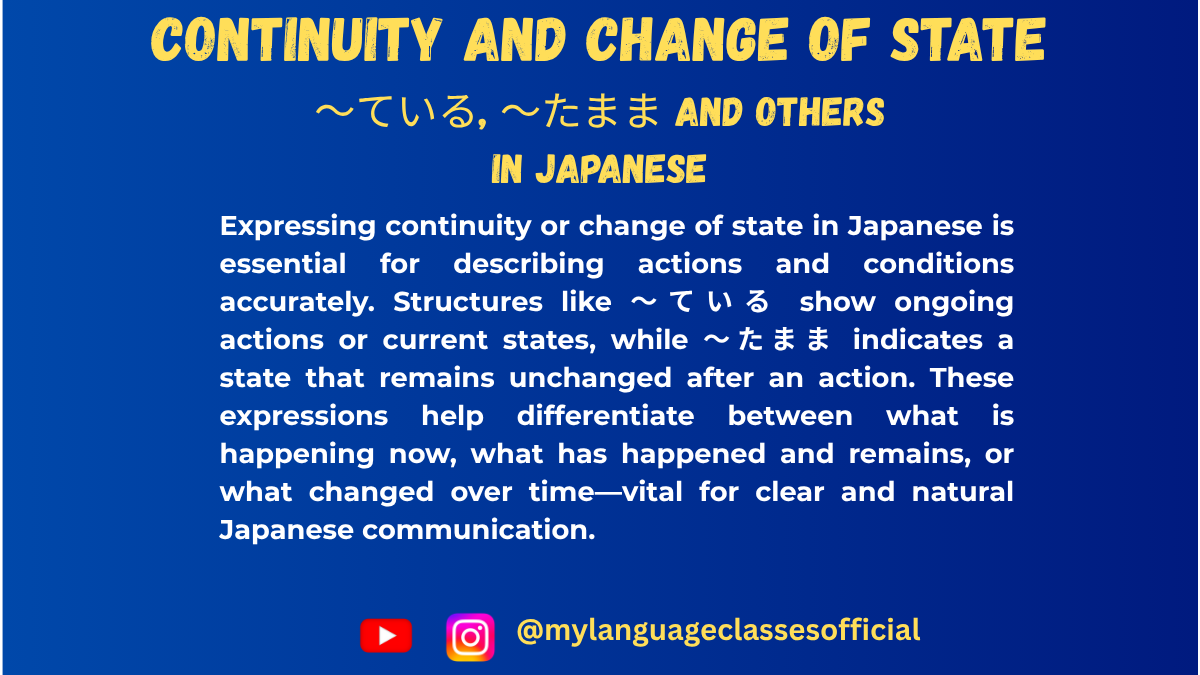
How to Show Continuity in Japanese | My Language Classes
Expressing Continuity or Change of State in Japanese
In Japanese, understanding how to express ongoing actions, states, or transitions is essential for achieving fluency. These expressions allow speakers to describe actions in progress, habitual actions, or states resulting from actions. In this blog, we’ll dive into various patterns to express continuity or a change of state, starting with the well-known Verb て-form + いる, and expanding into other structures and nuances.
1. Verb て-form + いる (~ている)
Usage:
- Continuous Action: Indicates an action currently in progress.
- Example:
- 本を読んでいる。
(Hon o yonde iru.)
“I am reading a book.”
- 本を読んでいる。
- Example:
- Resultant State: Refers to the state resulting from an action.
- Example:
- ドアが開いている。
(Doa ga aite iru.)
“The door is open.” (The action of opening has occurred, and the state is ongoing.)
- ドアが開いている。
- Example:
- Habitual Action: Expresses something done regularly or habitually.
- Example:
- 毎朝ジョギングをしている。
(Maiasa jogingu o shite iru.)
“I jog every morning.”
- 毎朝ジョギングをしている。
- Example:
Points to Keep in Mind:
- The context determines whether it refers to an ongoing action, a resultant state, or a habitual action.
- In casual speech, いる is often contracted to る or omitted entirely. For example:
- 読んでる instead of 読んでいる.
2. Verb Stem + 続ける (~つづける)
This pattern expresses the idea of continuing an action without stopping.
Usage:
- Continuous Action: Indicates persistence or continuity of an action.
- Example:
- 彼は勉強し続ける。
(Kare wa benkyou shi tsuzukeru.)
“He continues to study.”
- 彼は勉強し続ける。
- Example:
Points to Keep in Mind:
- The verb 続ける (to continue) can also be conjugated, e.g., 続けます (formal), 続けた (past tense).
- This structure emphasizes effort or intention behind continuity.
3. Verb た-form + まま
This structure expresses the idea of a state being left unchanged.
Usage:
- Unchanged State: Indicates that something remains in its current state.
- Example:
- 靴を履いたまま部屋に入らないでください。
(Kutsu o haita mama heya ni hairanaide kudasai.)
“Please don’t enter the room with your shoes on.”
- 靴を履いたまま部屋に入らないでください。
- Example:
Points to Keep in Mind:
- The subject must remain in the state expressed by the verb.
- Often used to highlight an undesirable or unintended state.
4. Noun + のまま
Similar to the verb usage, this pattern expresses an unchanged state with nouns.
Usage:
- Unchanged State: Describes a situation where something stays the same.
- Example:
- 冷たい飲み物のまま飲んだ。
(Tsumetai nomimono no mama nonda.)
“I drank it while it was still cold.”
- 冷たい飲み物のまま飲んだ。
- Example:
5. Verb Base + ながら
The ~ながら form allows for the expression of two simultaneous actions.
Usage:
- Simultaneous Actions: Describes doing one action while performing another.
- Example:
- 音楽を聴きながら勉強する。
(Ongaku o kikinagara benkyou suru.)
“I study while listening to music.”
- 音楽を聴きながら勉強する。
- Example:
Points to Keep in Mind:
- The main focus is usually on the action described by the main clause.
- Both actions must involve the same subject.
6. Adjective + まま
Describes a state where something remains as it is, often with adjectives.
Usage:
- Unchanged Condition:
- Example:
- 暑いままで寝てしまった。
(Atsui mama de nete shimatta.)
“I fell asleep while it was still hot.”
- 暑いままで寝てしまった。
- Example:
7. Verb て-form + いく / Verb て-form + くる
These forms express a change of state over time or movement.
Usage:
- ~ていく: Indicates a progression away from the present or current state.
- Example:
- 暗くなっていく。
(Kuraku natte iku.)
“It’s getting darker.”
- 暗くなっていく。
- Example:
- ~てくる: Indicates a progression towards the present or a return to the current state.
- Example:
- 涼しくなってきた。
(Suzushiku natte kita.)
“It has started to become cool.”
- 涼しくなってきた。
- Example:
Points to Keep in Mind:
- These forms are particularly useful for describing gradual or dynamic changes.
8. Verb Stem + 出す / Verb Stem + 始める
Both patterns describe the initiation of an action or state.
Usage:
- ~出す: Indicates a sudden or spontaneous beginning of an action.
- Example:
- 赤ちゃんが泣き出した。
(Akachan ga nakidashita.)
“The baby started crying.”
- 赤ちゃんが泣き出した。
- Example:
- ~始める: Describes the commencement of an action.
- Example:
- 本を読み始める。
(Hon o yomihajimeru.)
“I start reading a book.”
- 本を読み始める。
- Example:
Points to Keep in Mind:
- 出す suggests a more abrupt or unexpected start, while 始める implies a deliberate beginning.
Final Thoughts:
When discussing continuity or a change of state in Japanese, understanding the nuances of these patterns is crucial. The choice of expression depends on context, intent, and the subtleties of the situation being described. Here are some key points to remember:
- Context is king: Be mindful of whether you’re describing an ongoing action, a habitual action, or a resultant state.
- Nuance matters: Patterns like ~ていく and ~てくる convey subtle differences in directionality or emotional tone.
- Practice in context: Try creating sentences using each pattern to internalize their meanings and usage.
By mastering these structures, you can convey complex temporal and state-related concepts in Japanese with clarity and precision. Happy learning! 😊
If you enjoyed this lesson, be sure to check out more posts like this on my blog at My Language Classes. Don’t forget to subscribe my YouTube channel and follow me on Instagram for the latest language learning tips and lessons. Leave a comment below to share your thoughts, or ask any questions you have about nouns.
Happy learning! 😊
- Continuous Action: Indicates an action currently in progress.
-
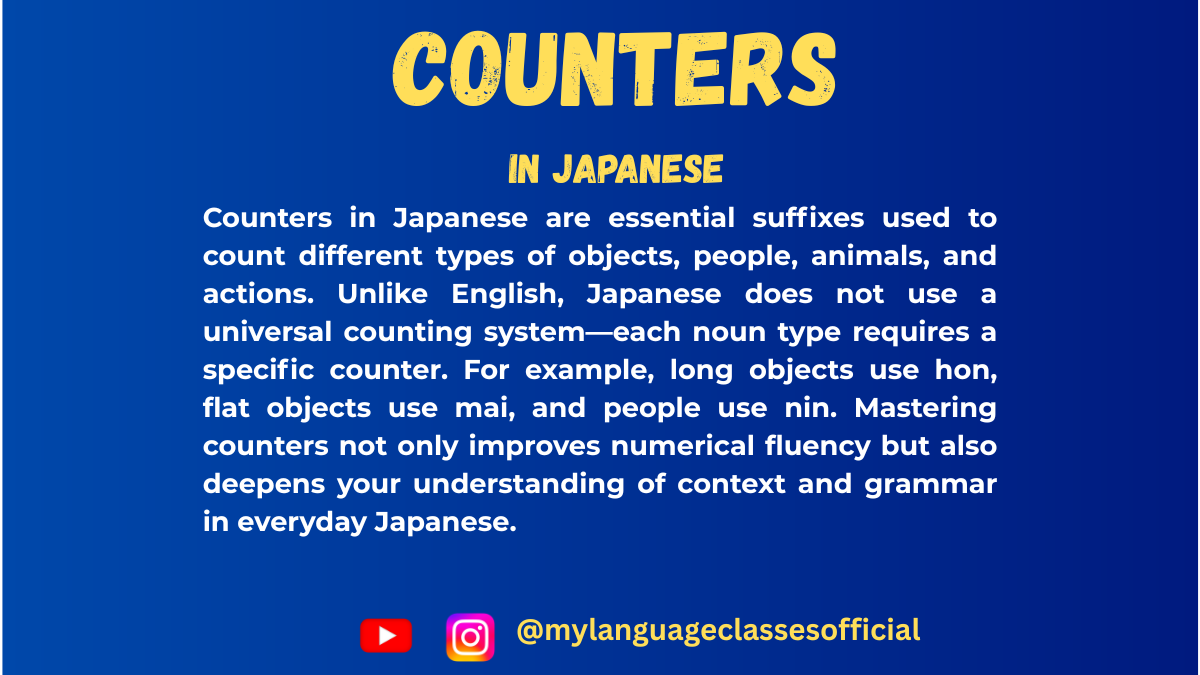
Mastering Japanese Counters | My Language Classes
Mastering Japanese Counters
When learning Japanese, one unique and challenging aspect for learners is the use of counters. Unlike English, Japanese uses specific words when counting objects, animals, people, and even abstract concepts. These counters change depending on the type and shape of the item being counted. In this post, we’ll delve deep into the world of Japanese counters, explain the logic behind them, and provide tips to use them confidently in everyday conversation.
What Are Counters in Japanese?
Counters are suffixes used to indicate the type or category of the item being counted. For example:
- 本 (ほん) is used for long, cylindrical objects like bottles or pencils.
- 枚 (まい) is for thin, flat objects like paper or plates.
- 匹 (ひき) is for animals like cats or fish.
To count items, you combine a number with the appropriate counter, often modifying the pronunciation depending on the number.
Basic Structure
The typical structure is:
Number + Counter
Examples:
- 一本 (いっぽん) — one pen (using the counter for long objects)
- 三枚 (さんまい) — three sheets of paper (using the counter for flat objects)
- 五匹 (ごひき) — five dogs (using the counter for animals)
However, it’s important to know irregular pronunciations, which often occur with numbers like 1, 3, 6, and 8. We’ll discuss this in detail below.
Common Counters and Their Usage
Here are some of the most frequently used counters:
1. General Items: 個 (こ)
Used for small, generic objects.
- Examples: 一個 (いっこ) — one piece, 三個 (さんこ) — three pieces.
2. Long Objects: 本 (ほん)
Used for items like pens, bottles, trees, and trains.
- Irregular pronunciations:
- 1本 (いっぽん)
- 3本 (さんぼん)
- 6本 (ろっぽん)
3. Flat Objects: 枚 (まい)
Used for items like paper, plates, and T-shirts.
- Examples: 一枚 (いちまい) — one sheet, 十枚 (じゅうまい) — ten sheets.
4. People: 人 (にん)
Used for counting people, with some exceptions:
- 1 person: 一人 (ひとり)
- 2 people: 二人 (ふたり)
- 3 or more: Regular pattern (三人 [さんにん], etc.).
5. Animals: 匹 (ひき)
Used for small animals like cats, dogs, and fish.
- Irregular pronunciations:
- 1匹 (いっぴき)
- 3匹 (さんびき)
- 6匹 (ろっぴき)
6. Books and Magazines: 冊 (さつ)
Used for bound objects like books and notebooks.
- Irregular pronunciations:
- 1冊 (いっさつ)
- 8冊 (はっさつ)
7. Machines and Vehicles: 台 (だい)
Used for cars, TVs, and other machinery.
- Examples: 一台 (いちだい), 五台 (ごだい).
8. Large Animals: 頭 (とう)
Used for cows, horses, and elephants.
- Examples: 一頭 (いっとう), 三頭 (さんとう).
Tips to Master Counters
- Start with Common Counters: Focus on frequently used counters like 個, 本, and 枚 before delving into specialized ones.
- Memorize Irregular Forms: Pay attention to irregular readings for numbers like 1, 3, 6, and 8.
- Practice with Real-Life Examples: Use counters in context, like ordering food or describing objects around you. For instance:
- レストランで: コーヒーを二杯 (にはい)ください (At a restaurant: “Two cups of coffee, please.”).
- Watch Native Speakers: Listen to native speakers to understand how counters are naturally used in conversation.
Things to Keep in Mind
- Context Matters: The appropriate counter often depends on the item’s size, shape, or category.
- Colloquial Shortcuts: In casual conversation, native speakers may drop the counter altogether if the context is clear:
- Example: りんご三つ (みっつ) instead of 三個.
- Counters for Abstract Concepts: Words like 回 (かい) for times or 度 (ど) for occurrences can be tricky. Practice distinguishing them:
- 一回 (いっかい) — once
- 一度 (いちど) — one time (but often implies a more formal or singular occasion).
Learning Through Examples
Here are some sample sentences to see counters in action:
- Books and Magazines:
- 本を三冊買いました。
(ほんをさんさつかいました)
I bought three books.
- 本を三冊買いました。
- Animals:
- 犬が五匹います。
(いぬがごひきいます)
There are five dogs.
- 犬が五匹います。
- Drinks:
- ビールを二杯ください。
(びーるをにはいください)
Two beers, please.
- ビールを二杯ください。
- People:
- 学生が十人来ました。
(がくせいがじゅうにんきました)
Ten students came.
- 学生が十人来ました。
Practice Makes Perfect
To truly master Japanese counters, practice is essential. Start by identifying objects around you and attaching the appropriate counter. Here’s a challenge for you:
- Look around your room and count:
- Books (冊)
- Pens (本)
- Chairs (台)
- Photos (枚).
By incorporating counters into daily life, you’ll quickly become more comfortable and natural when speaking Japanese.
Final Thoughts
Japanese counters can feel overwhelming at first, but they also add precision and beauty to the language. By focusing on common counters, practicing regularly, and immersing yourself in authentic Japanese content, you’ll be able to master this unique aspect of Japanese in no time. Keep practicing, and don’t be afraid to make mistakes—they’re the stepping stones to fluency. 頑張ってね!(Good luck!)
If you enjoyed this lesson, be sure to check out more posts like this on my blog at My Language Classes. Don’t forget to subscribe my YouTube channel and follow me on Instagram for the latest language learning tips and lessons. Leave a comment below to share your thoughts, or ask any questions you have about nouns.
Happy learning! 😊

